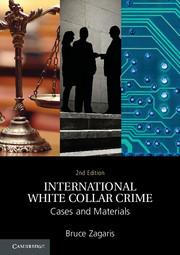Book contents
- Frontmatter
- Contents
- Preface
- 1 Introduction
- 2 Taxation
- 3 Money Laundering and Counterterrrorism Financial Enforcement
- 4 Transnational Corruption
- 5 Transnational Organized Crime
- 6 Export Control and Economic Sanctions
- 7 International Environmental Crimes
- 8 International Securities Enforcement
- 9 Extraterritorial Jurisdiction
- 10 International Evidence Gathering
- 11 Extradition and Alternatives
- 12 International Prisoner Transfer
- 13 The United Nations
- 14 The World Bank Group
- 15 INTERPOL
- 16 Economic Integration and Business Crimes
- Index
- References
8 - International Securities Enforcement
Published online by Cambridge University Press: 05 November 2015
- Frontmatter
- Contents
- Preface
- 1 Introduction
- 2 Taxation
- 3 Money Laundering and Counterterrrorism Financial Enforcement
- 4 Transnational Corruption
- 5 Transnational Organized Crime
- 6 Export Control and Economic Sanctions
- 7 International Environmental Crimes
- 8 International Securities Enforcement
- 9 Extraterritorial Jurisdiction
- 10 International Evidence Gathering
- 11 Extradition and Alternatives
- 12 International Prisoner Transfer
- 13 The United Nations
- 14 The World Bank Group
- 15 INTERPOL
- 16 Economic Integration and Business Crimes
- Index
- References
Summary
Introduction
Over the past several decades, modern securities markets, and many market participants have become globalized. Their operations cross borders and draw on investment capital around the world. They look for investment opportunities in many different countries. Simultaneously and for the foreseeable future, market oversight remains a local affair, with national or provincial-level regulators implementing legislation enacted by their jurisdictions’ legislatures.
Legislatures and financial regulators worldwide have recommitted themselves to strengthening their financial regulatory systems to correct the weaknesses that the 2008 financial crisis has uncovered. However, in many cases, the global nature of many market participants (large investment banks, credit rating agencies, investment advisers, hedge funds et al.) will likely make purely domestic responses to regulatory weaknesses less than fully effective. Globally active market participants often have significant portions of their operations, data, staff, capital and assets in multiple jurisdictions. Regulators often respond by requiring that a regulated entity's overseas operations must comply with domestic standards and oversight requirements prior to being allowed to engage in domestic business. Still, confirmation and enforcement of these requirements can prove challenging.
Even where securities regulators have in place enforcement cooperation mechanisms, such as bilateral and the IOSCO Multilateral Memorandum of Understanding Concerning Consultation and Cooperation and the Exchange of Information (IOSCO MMOU), the day-to-day information outside of an enforcement context that a regulator needs in order to exercise effective oversight may be difficult to access, without the assistance and cooperation of the relevant counterpart. Although regulators have different supervisory approaches and laws, each has a common interest in information-sharing and cooperation based on earned trust in each other's regulatory and supervisory systems.
This chapter discusses the United States approach to securities enforcement cooperation and the international approach as contained in the initiatives and activities of the International Organization of Securities Commissions (IOSCO).
- Type
- Chapter
- Information
- International White Collar CrimeCases and Materials, pp. 283 - 318Publisher: Cambridge University PressPrint publication year: 2015
References
- 1
- Cited by



